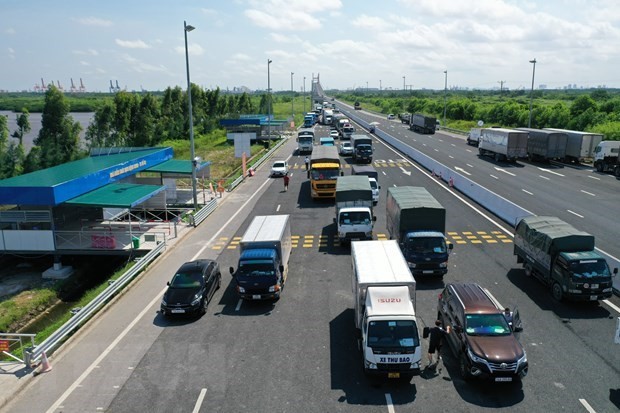
Quang Ninh targets highest possible growth rate this year
Latest
 |
| Vehicles wait for drivers to make health declarations on the road to Bach Dang Bridge in Quang Ninh province. (Photo: VNA) |
Authorities of Quang Ninh held that in the remaining months of 2021, the pandemic will keep developing complicatedly and greatly affecting production, business, services, tourism, and budget collection activities.
To obtain a double-digit growth rate, the provincial People’s Committee has built three growth scenarios for Q4 and the entire year, with advantages, difficulties, and growth in each sector taken into account.
The Standing Board of the provincial Party Committee agreed that Quang Ninh will exert efforts to achieve this year’s targets, set in the provincial Party Committee’s Resolution 02-NQ/TU, at the highest possible level. Accordingly, the gross regional domestic product (GRDP) growth is expected at over 10 percent and budget revenue to match the economic expansion.
To that end, the Standing Board emphasised the need to resolutely and persistently keep “green zones” safe, push ahead with measures that have proved effective, and take flexible solutions based on the reality.
The province looks to complete vaccination for 100 percent of eligible residents against COVID-19 this year, combined with boosting the adherence to the 5K principle (“khau trang” - wearing facemasks, “khu khuan” - disinfection, “khoang cach” - keeping distance, “khong tu tap” - no gathering, and “khai bao y te” - making health declarations) and technology application.
It will also step up administrative reforms, further improve the local business and investment climate, and enhance discipline at grassroots public service agencies, aiming to stay among the top provinces and cities in terms of the Provincial Competitiveness Index (PCI), the Public Administration Reform (PAR) Index, the Satisfaction Index of Public Administration Services (SIPAS), and the Provincial Governance and Public Administration Performance Index (PAPI).
Besides, local authorities will promote the efficiency and effectiveness of state management over land and natural resources. They will also make detailed planning schemes for Ha Long city, the Quang Yen coastal economic zone, and others.
The apparatus of State agencies will be streamlined in tandem with bettering their performance efficiency and effectiveness.
Legal bottlenecks will be removed while poor-performing rice cultivation and forest land areas are converted, and site clearance for projects is accelerated. The coordination between state agencies and localities in Quang Ninh will be strengthened to boost the disbursement of all capital sources, thereby creating an impulse for growth.
In addition, provincial authorities are requesting investors to quickly complete infrastructure at Song Khoai, Nam Tien Phong, Bac Tien Phong, and Viet Hung industrial parks. They are also encouraging secondary investors to speed up manufacturing projects.
Despite the complex COVID-19 situation, which has substantially impacted all socio-economic aspects, Quang Ninh has still managed to achieve the “twin targets” of curbing the pandemic and boosting socio-economic development.
The GRDP growth rate in the first nine months of 2021 is estimated at 8.2 percent.
In particular, the processing and manufacturing industry has increased 36.2 percent year on year, serving as the main driving force for the industrial sector. It has made up for the pandemic-caused downturn in services, tourism, coal, and electricity sectors.
Meanwhile, nearly 34.38 trillion VND (over 1.5 billion USD) has been collected for the State budget, equivalent to 67 percent of this year’s target. Administrative reforms and the business environment have continued to be improved.
Quang Ninh is one of the three nuclei of the northern key economic region and viewed as a strategic destination in northern Viet Nam.
It looks to raise its GRDP by 10 percent on an annual average during 2020 - 2025, and the per capita GRDP to over 10,000 USD by 2025. The urbanisation rate is expected to surpass 75 percent, while the rate of poor households to go down to below 1 percent.
The province plans to complete new-style rural area building by the end of 2030.
























